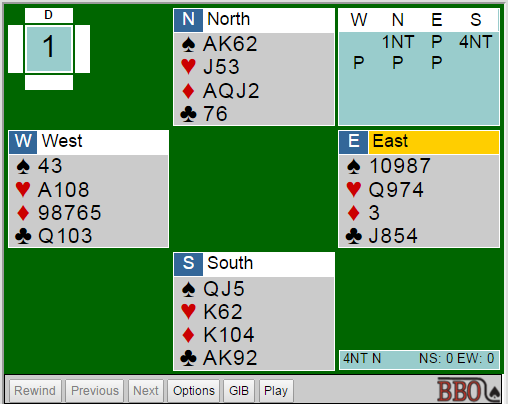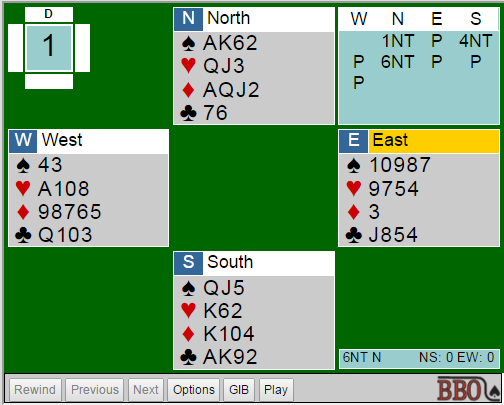Source: webutil.bridgebase.com ![]()
![]()
![]()
![]()
On Sundays, you can enjoy a free teaching session on BBO, hosted by different star players. This one was held, On Sunday, June 14 2015, by star player ![]() JDonn (Josh Donn). This was the first lecture in a series on Slam Bidding, and was followed by a Q&A session, where kibitzers were welcome to ask Josh questions.
JDonn (Josh Donn). This was the first lecture in a series on Slam Bidding, and was followed by a Q&A session, where kibitzers were welcome to ask Josh questions.
Hi everyone and welcome. I spent the last few lectures talking about preempting, but I am going to switch topics for a while now to slam bidding. Slam bidding is fun – after all, if you are investigating slam then your side must have good hands! But it’s also very important, since very big scores are on the line.
Throughout this series on slam bidding, I am going to review some very powerful tools. Some of them are very well known, such as Blackwood. Others are more advanced, but I will get to those in the future. But the first slam investigation tool I will review is the most basic: Quantitative slam bidding.
Quantitative bidding simply means bidding to a certain level based on how many values you hold. For example, if partner opens 1NT showing 15-17, and you hold 9 points, you might bid 2NT to invite game, because if partner is minimum you have 24 points and may not want to be in game, but if he is maximum you have 26 points and probably do want to be in game. That is an example of quantitative bidding.
Well, slam bidding can work the exact same way. The way you invite slam after partner opens 1NT is by raising to 4NT. Suppose you hold a balanced 16 points. If partner is a minimum with 15, you have 31 combined, which on two balanced hands is probably not quite enough for slam. But if partner is a maximum with 17 then you have 33 combined, almost always enough to make slam.
Let’s take an example hand and see how this works.
Suppose you hold ![]() QJ5
QJ5 ![]() K62
K62 ![]() KT4
KT4 ![]() AK92. If partner has
AK92. If partner has ![]() AK62
AK62 ![]() J53
J53 ![]() AQJ2
AQJ2 ![]() 76, a 15 point hand, he will pass 4NT. You have 10 easy tricks, 11 if the heart ace is onside, but that is all.
76, a 15 point hand, he will pass 4NT. You have 10 easy tricks, 11 if the heart ace is onside, but that is all.

However, improve the hand to ![]() AK62
AK62 ![]() QJ3
QJ3 ![]() AQJ2
AQJ2 ![]() 76, a 17 point hand, and partner will go on to slam, where there are 12 easy tricks after giving up the ace of hearts.
76, a 17 point hand, and partner will go on to slam, where there are 12 easy tricks after giving up the ace of hearts.

Quantitative bidding generally works well, especially on two balanced hands, but it’s not perfect so you shouldn’t expect miracles. Here are some of the reasons quantitative bidding doesn’t always reach the best contract:
Quantitative bidding is not an exact science.
Let’s go back to our hand of ![]() QJ5
QJ5 ![]() K62
K62 ![]() KT4
KT4 ![]() AK92. As I said, I would raise my partner’s 1NT opening to 4NT, hoping for him to pass if he is a minimum, or bid 6NT if he is a maximum.
AK92. As I said, I would raise my partner’s 1NT opening to 4NT, hoping for him to pass if he is a minimum, or bid 6NT if he is a maximum.
However, let’s look at some example hands for partner where this approach will not work very well. If partner has ![]() KT63
KT63 ![]() A4
A4 ![]() AQ2
AQ2 ![]() QT54 that is a minimum and he will pass, yet I am a big favorite to make 6NT, only needing to secure 4 clubs tricks.
QT54 that is a minimum and he will pass, yet I am a big favorite to make 6NT, only needing to secure 4 clubs tricks.

Now suppose he has ![]() AK3
AK3 ![]() A74
A74 ![]() AQ6
AQ6 ![]() 8543. That is a maximum with 17 where he will surely bid 6NT, yet that contract has no play at all – in fact you need clubs to break evenly just to make 11 tricks!
8543. That is a maximum with 17 where he will surely bid 6NT, yet that contract has no play at all – in fact you need clubs to break evenly just to make 11 tricks!

Why does this happen? Well you don’t know for sure how much each high card you hold will be worth on that particular hand. If you hold QJ5 of a suit like the spades in our example hand, does partner have AK3, which means your jack is useless since Q52 would be the same 3 tricks? Or does partner have KT63, meaning your jack guarantees three tricks without needing an even break in the suit? We don’t know what holding partner has in each suit. So what is the jack worth each time you pick it up? You won’t know until you see your partner’s hand.
My point is, when you bid quantitatively, you are playing the odds. You don’t know exactly which tricks you will and won’t take, but you know that on average a certain amount of points will be enough to make a certain contract, so you aim to get there when you have that many points and then hope it was right. As those examples show, it doesn’t work perfectly, but it does work very well.
Quantitative bidding is not 100% precise.
What I mean by this is, you won’t always reach the exact same level with the exact same amount of high card points. This is most easily demonstrated with some very simple math. Suppose when partner opens 1NT 15-17 and you are balanced, your goal is to reach 6NT only with at least 33 high card points between your hands. That could be the case if you hold either 16 or 17 points, since with 16-17 you will not have enough if partner has 15 and you will have enough if partner has 17, so you might bid 4NT with either amount. But then how does partner know what to do with 16 himself? If you hold 16 that is only 32 combined, but if you hold 17 that is 33 combined.
The answer is, partner doesn’t know what to do for sure. Partner will have to judge based on other factors such as distribution and spot cards. I am not attempting to discuss how partner will evaluate his hand, but just making the point that you can’t get to 6NT with 33 and stop in 4NT with 32 100% of the time. Sometimes a hand in the middle of the range will guess wrong, and that’s just how it goes.
Esta entrada también está disponible en: Spanish

